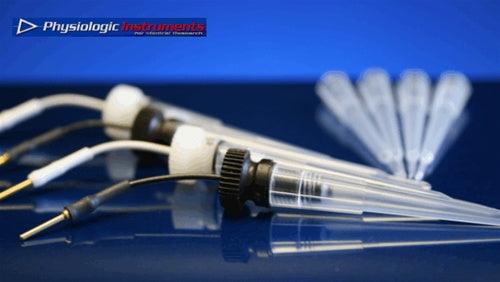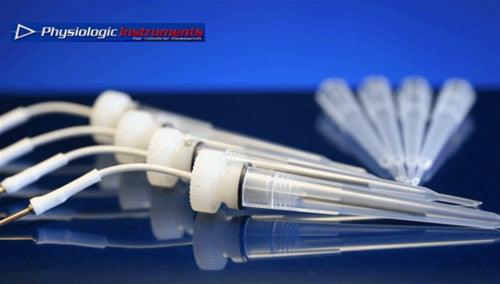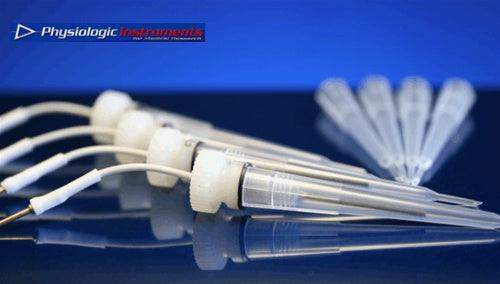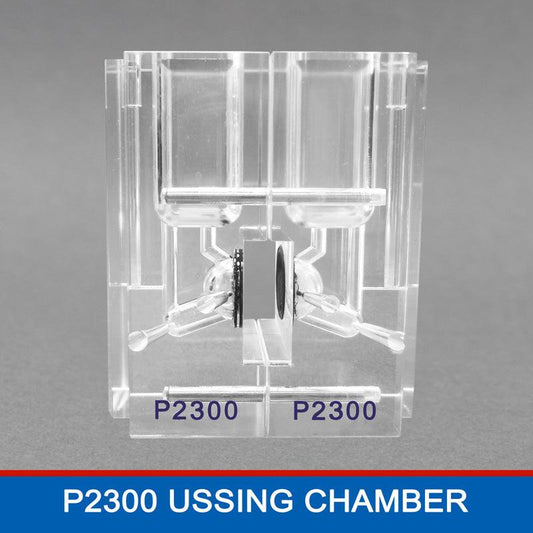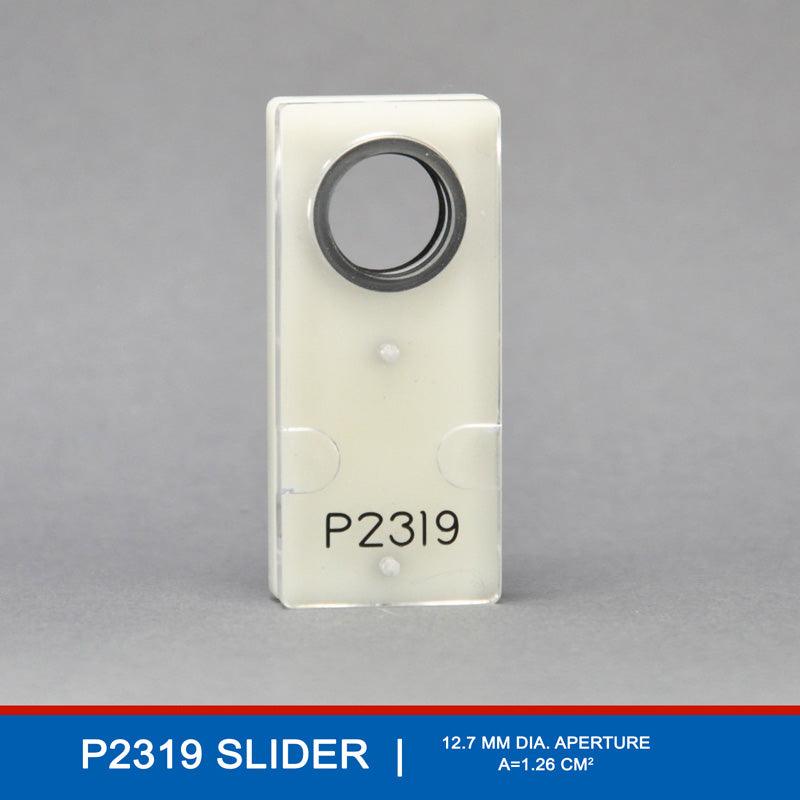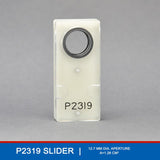P2319 EasyMount Ussing Chamber Slider
The P2319 EasyMount Ussing Chamber Slider is purpose-built for transport studies through mucus layers, featuring a 12.7 mm diameter and an effective 1.26 cm² area that ensures optimal sample exposure within the P2300 Ussing Chamber.
This EasyMount's defining feature is a specially designed spacer ring (15.6 mm OD x 12.7 mm ID x 2.8 mm HT) that creates a stable, enclosed space between two permeable membranes, allowing mucus or similar viscous samples to be securely held in place. This setup facilitates precise measurements of diffusion and transport through the mucus, preventing sample loss or contamination. By including one spacer ring with the slider, the P2319 offers a highly reproducible setup for researchers focusing on transport, permeability, and diffusion studies in mucosal or gel-like media, making it an invaluable tool for physiological and pharmacological investigations.
⦿ To be used with P2300 EasyMount Ussing Chambers- Regular price
- $229.00
- Regular price
-
- Sale price
- $229.00
- Unit price
- per
EasyMount Slider Details

P2319 EasyMount Ussing Chamber Slider for Studying Transport through Mucus
APETURE SIZE: 12.7MM | Area = 1.26 cm2
The P2319 EasyMount Ussing Chamber Slider is a 12.7 mm diameter tissue holder meticulously designed for use with the EasyMount Ussing Chamber model P2300, ideal for studies focused on transport processes through mucus layers. This slider is specifically configured to accommodate a unique spacer ring (15.6 mm OD x 12.7 mm ID x 2.8 mm HT), which serves to separate two permeable membranes, creating an enclosed space for the mucus sample. This spacer design allows for precise placement of the mucus between the membranes, facilitating accurate assessment of transport phenomena through the mucus layer while avoiding sample loss or contamination.
With an effective surface area of 1.26 cm², the P2319 slider provides ample exposure for reliable measurements across the mucus interface. The slider includes one spacer ring to ensure repeatable positioning, enabling consistent experimental setups and reproducible data. This configuration is highly suited for researchers investigating diffusion, permeability, or transport kinetics through mucus or other similar gel-like barriers. When paired with the P2300 Ussing Chamber system, the P2319 EasyMount Slider supports rigorous and reproducible studies, offering a specialized solution for examining physiological transport processes through mucosal or other viscous media.
P2319 EasyMount Ussing Chamber Slider Instructions
To effectively use the P2319 EasyMount Slider in an experiment with the P2300 Ussing Chamber system, follow this guide on preparing, assembling, and conducting the study with mucus or similar samples enclosed between two permeable membranes within the specialized spacer ring.
1. Preparing the Membranes and Mucus Sample
- Select Permeable Membranes: Choose two permeable membranes suitable for your transport study. These membranes should be compatible with the physiological or pharmacological solutions in the chamber and allow transport of ions or molecules of interest.
- Prepare the Mucus Sample: Collect or prepare the mucus or other viscous sample to be studied. Ensure the sample volume is sufficient to form a thin layer within the spacer ring, as this will form the barrier for your transport measurements.
2. Assembling the P2319 Ussing Chamber Slider with the Spacer Ring and Membranes
- Position the First Membrane: Place one of the permeable membranes flat onto the P2319 slider aperture. Ensure it fully covers the 1.26 cm² area and is evenly positioned to prevent gaps or folds that could disrupt the seal.
- Insert the Spacer Ring: Place the included spacer ring (15.6 mm OD x 12.7 mm ID x 2.8 mm HT) on top of the first membrane, aligning it with the slider’s aperture. This ring will act as the enclosure for the mucus sample and create a consistent thickness for diffusion studies.
- Add the Mucus Layer: Carefully introduce the mucus sample into the center of the spacer ring, spreading it evenly to form a uniform layer. Take care to avoid bubbles or uneven distribution, as these could affect transport measurements.
- Position the Second Membrane: Place the second permeable membrane over the spacer ring, ensuring it completely covers the ring and sample. This membrane completes the assembly and seals the mucus within a controlled space between the two membranes.
3. Inserting the Assembled Slider into the P2300 Ussing Chamber
- Prepare the Chamber: Fill each compartment of the P2300 Ussing Chamber with the appropriate physiological solutions. These solutions may contain different ion concentrations or experimental compounds, depending on the specific parameters you wish to measure.
- Mount the Slider: Carefully insert the P2319 Ussing chamber slider, now assembled with the membranes and spacer ring, into the P2300 Ussing Chamber. Align it to ensure a tight, leak-free fit, so each membrane side faces a different chamber compartment.
- Electrode Placement: Position electrodes (such as voltage or current electrodes) within each compartment of the chamber according to the P2300’s specifications. This setup enables the measurement of electrical potential or ion transport across the mucus layer.
4. Conducting the Experiment
- Baseline Measurements: Before introducing any experimental variables, record baseline measurements, such as transepithelial resistance (TER) or potential difference, to establish initial conditions and confirm membrane integrity.
- Introduce Experimental Conditions: Add any experimental treatments, such as drugs or ion-specific solutions, to one side of the chamber if you’re studying asymmetric transport across the mucus layer.
- Monitor Data: Continuously record the relevant parameters, including changes in TER, short-circuit current (Isc), or ion fluxes, to analyze the transport properties of the mucus layer in response to the experimental conditions.
5. Completing the Experiment and Cleaning
- Data Analysis: After completing the experiment, save and analyze the data to interpret the transport or permeability properties of the mucus layer.
- Disassemble and Clean: Carefully remove the P2319 slider from the chamber. Remove and dispose of the membranes and mucus sample as appropriate. Rinse the slider, spacer ring, and chamber components with distilled water, followed by a suitable cleaning solution, to prepare them for future experiments.
By following these steps, the P2319 EasyMount Ussing Chamber Slider and P2300 Ussing Chamber system provide an accurate and reproducible setup for studying transport processes through mucus layers. The spacer ring design ensures uniform sample thickness and a secure seal between membranes, making this configuration ideal for investigating diffusion, permeability, and other transport dynamics in viscous media.


